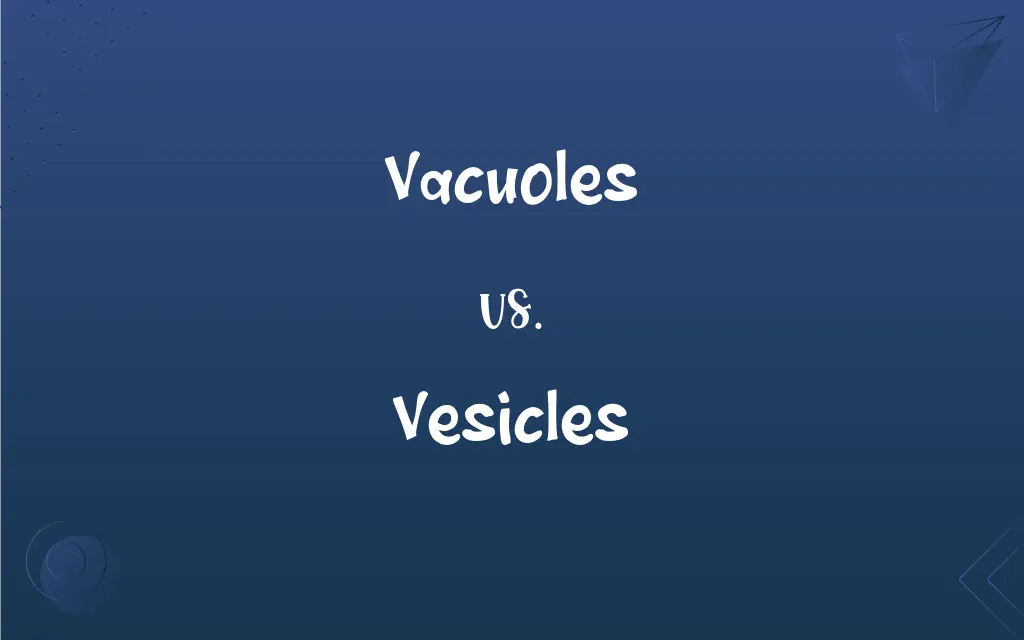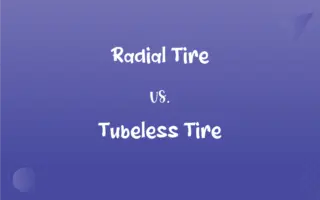Vacuoles vs. Vesicles: What's the Difference?
Edited by Aimie Carlson || By Janet White || Published on January 31, 2024
Vacuoles are large, membrane-bound sacs in cells for storage and waste disposal, while vesicles are small, membrane-bound sacs for transport within cells.

Key Differences
Vacuoles are large storage sacs found mainly in plant cells, holding materials like water, nutrients, and waste. They play a key role in maintaining cell turgor and pH balance. In contrast, vesicles are much smaller and are found in many types of cells, primarily involved in the transport of materials within a cell, like proteins and lipids.
The function of vacuoles varies from storage to maintaining cell structure. In plants, they store water, contributing to cell rigidity. Vesicles, however, are central to cellular processes like endocytosis and exocytosis, facilitating the movement of substances in and out of the cell.
In terms of origin, vacuoles often form from the endoplasmic reticulum and Golgi apparatus and can occupy a significant portion of the cell volume in plants. Vesicles are also derived from the Golgi apparatus and endoplasmic reticulum but are used for more dynamic processes like secretion and membrane recycling.
Vacuoles have an additional role in degradation, similar to lysosomes in animal cells, containing enzymes that break down cellular waste and macromolecules. Vesicles, on the other hand, can specialize in different functions, including transporting enzymes, neurotransmitters, and other cell-specific substances.
The size difference between vacuoles and vesicles is significant. Vacuoles are usually larger and fewer in number, while vesicles are smaller and more numerous, highlighting their different roles in cellular storage and transport.
ADVERTISEMENT
Comparison Chart
Size and Number
Larger, fewer
Smaller, numerous
Primary Function
Storage and waste disposal
Transport of materials
Cellular Role
Maintain cell structure, store nutrients
Mediate endocytosis, exocytosis, transport within the cell
Location
Mainly in plant cells
In many types of cells
Formation
From the ER and Golgi apparatus
From the Golgi apparatus and ER
ADVERTISEMENT
Vacuoles and Vesicles Definitions
Vacuoles
Sacs containing enzymes for degradation in plant cells.
The vacuole breaks down waste materials in the cell.
Vesicles
Organelles involved in cellular processes like secretion.
Secretory vesicles release hormones outside the cell.
Vacuoles
Organelles for storing nutrients and maintaining pH balance.
Nutrients are stored in the vacuole for later use by the cell.
Vesicles
Vesicles facilitate endocytosis and exocytosis in cells.
The cell absorbed nutrients through endocytic vesicles.
Vacuoles
Membrane-bound sacs in cells for storage and waste disposal.
The vacuole in the plant cell stores water to maintain turgidity.
Vesicles
Carriers of enzymes and neurotransmitters in cells.
Neurotransmitters are released at synapses via vesicles.
Vacuoles
Large organelles in plant cells for maintaining cell structure.
The central vacuole occupies most of the cell's volume.
Vesicles
Small, membrane-bound sacs for transporting materials within cells.
Vesicles transport proteins from the Golgi to other parts of the cell.
Vacuoles
A key component in plant cells for osmoregulation.
Vacuoles regulate the water content in cells.
Vesicles
Components in intracellular trafficking and membrane recycling.
Vesicles play a role in recycling cell membrane components.
Vacuoles
A membrane-bound organelle in the cytoplasm of most cells, especially plant cells, containing water and dissolved substances such as salts, sugars, enzymes, and amino acids.
Vesicles
(Cytology) A membrane-bound structure within a cell in which materials such as enzymes are transported or stored.
Vacuoles
A small extracellular cavity or space within tissues.
Vesicles
(Anatomy) A sac or cyst, especially one containing fluid.
Vacuoles
Plural of vacuole
Vesicles
(Medicine) A blister of the skin.
Vesicles
(Geology) A cavity formed in volcanic rock by entrapment of a gas bubble during solidification.
Vesicles
Plural of vesicle
FAQs
What materials do vesicles transport?
Proteins, lipids, neurotransmitters, and waste products.
What is a vesicle?
A small, membrane-bound sac in cells for transporting materials.
Are vacuoles only found in plant cells?
Primarily, but they are also in some fungi and animal cells.
What is a vacuole?
A large, membrane-bound organelle in cells, mainly for storage.
Do vacuoles exist in animal cells?
They're less common and smaller in animal cells than in plants.
Do vesicles participate in immune responses?
Yes, by transporting immune-related molecules.
Do vesicles move freely in cells?
Yes, they move along cytoskeletal tracks within the cell.
Can vacuoles help in cell growth?
Yes, by storing nutrients and water for cell expansion.
How do vesicles aid in cell communication?
By transporting and releasing signaling molecules like neurotransmitters.
What's the role of vacuoles in plant cells?
To maintain structure, store nutrients, and dispose of waste.
What is the function of contractile vacuoles?
To expel excess water and maintain osmotic balance, mostly in protists.
How do vacuoles affect plant turgidity?
By storing water, they help maintain plant rigidity.
How do vesicles help in protein trafficking?
By carrying proteins to various parts of the cell or outside it.
What role do vesicles play in endocytosis?
They help internalize substances from outside the cell.
How are vesicles formed?
From the budding off of the Golgi apparatus or endoplasmic reticulum.
Do vesicles have a single function in cells?
No, they have multiple functions, including transport and secretion.
Are vesicles reusable in cells?
Yes, they can be reused for multiple transport cycles.
What is the pH inside a vacuole?
It can be acidic, especially if it functions in degradation.
Can vacuoles store harmful substances?
Yes, they can isolate potentially harmful materials from the rest of the cell.
Are vacuoles involved in photosynthesis?
Indirectly, by storing water and nutrients used in the process.
About Author
Written by
Janet WhiteJanet White has been an esteemed writer and blogger for Difference Wiki. Holding a Master's degree in Science and Medical Journalism from the prestigious Boston University, she has consistently demonstrated her expertise and passion for her field. When she's not immersed in her work, Janet relishes her time exercising, delving into a good book, and cherishing moments with friends and family.
Edited by
Aimie CarlsonAimie Carlson, holding a master's degree in English literature, is a fervent English language enthusiast. She lends her writing talents to Difference Wiki, a prominent website that specializes in comparisons, offering readers insightful analyses that both captivate and inform.































































